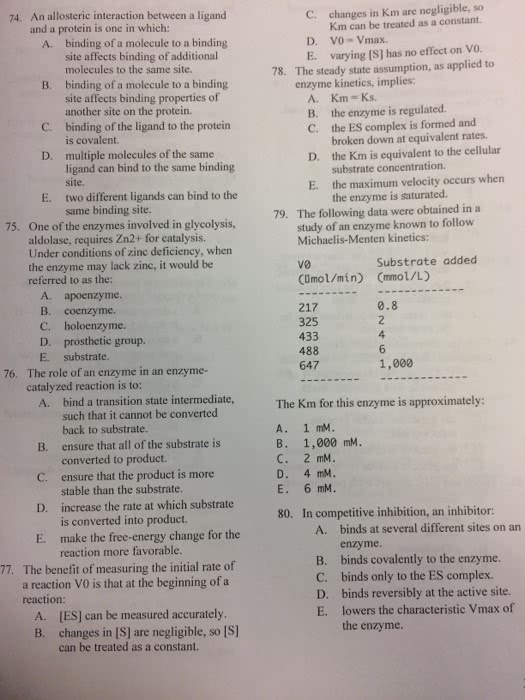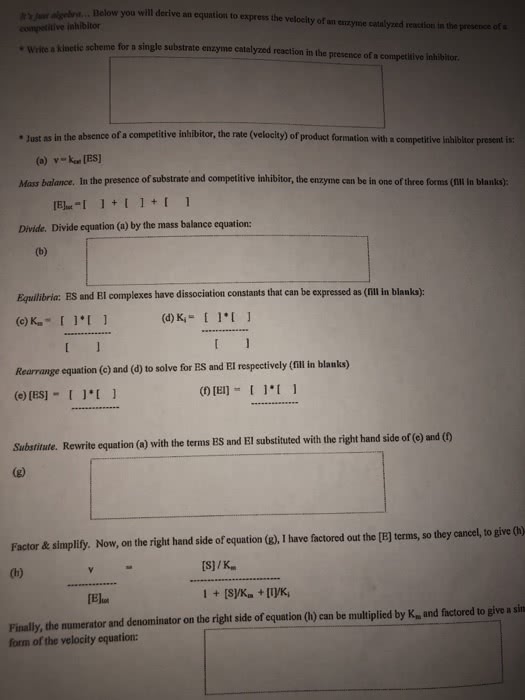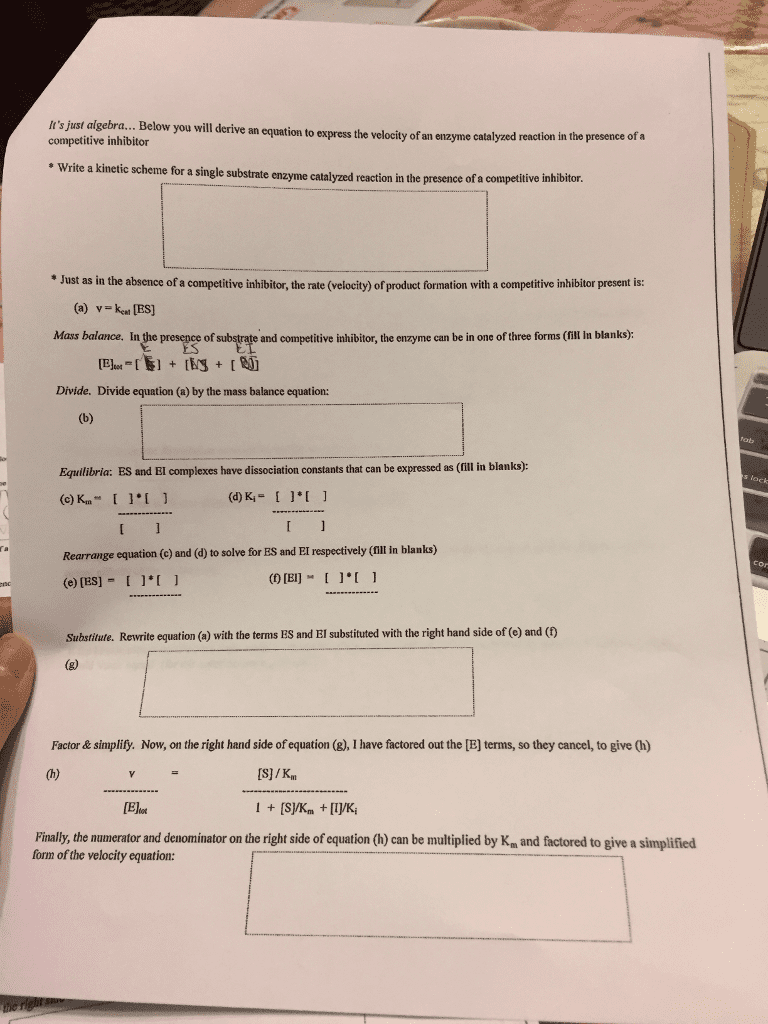CHEM 153A Chapter pg 346-355: CHEM 153A Chapter pg 346-35: CHEM 153A Chapter pg 346-3: CHEM 153A Chapter pg 346-: CHEM 153A Chapter pg 346: CHEM 153A Chapter pg 34: CHEM 153A Chapter pg 3: CHEM 153A Chapter pg : Enzyme Kinetics pg 346

Enzyme Kinetics pg 346-356
Pg 346
To understand how an enzyme enhances the rate of a reaction, we must understand enzyme kinetics.
First, we describe a reaction in simple terms proceeding as follows E + S ⇄ ES -> E + P where E is enzyme,
S is substrate, and P is product.
In this scheme, ES is the Enzyme-Substrate complex, which is simply the enzyme bound to its substrate.
We could define the ES state a bit further with E + S ⇄ ES -> ES* -> EP -> E + P where ES* is the activated
state and EP is the enzyme-product complex before release of the product.
Pg347
The velocity of a reaction is the rate of creation of product over time, measured as the concentration of
product per time. The time is a critical consideration when measuring velocity.
In a closed system (in which an enzyme operates), all reactions will advance towards equilibrium.
Enzymatically catalyzed reactions are no different in the end result from non-enzymatic reactions,
except that they get to equilibrium faster.
At equilibrium, the ratio of product to reactant does not change. That is a property of equilibrium. Since
the system is closed, the concentration of product over time will not change.
The velocity will thus be zero under these conditions and we will have learned nothing about the
reaction if we wait too long to study it.
Consequently, in MichaelisMenten kinetics, velocity is measured as initial velocity (V0).
Pg348
Thus, the enzyme would “wait” for substrate to bind if there were not sufficient amounts of it to bind to
the enzyme in a timely fashion (when substrate concentration is low).
find more resources at oneclass.com
find more resources at oneclass.com

This would not give an accurate measure of velocity, since the enzyme would be inactive a good deal of
the time. Because of this, we assume saturation of the enzyme with substrate will give a maximal
velocity of the reaction.
Last, the high concentration of substrate combined with measuring initial conditions results in studying
reactions that are under so-called steady state conditions (Figure 4.17). When steady state occurs, the
concentration of the ES complex over time is not significantly changing during the period of analysis.
Pg349
the three assumptions for Michaelis-Menten kinetics are
1. Measurement of initial velocity of a reaction 2. Substrate in great excess compared to enzyme 3.
Reaction conditions occurring under steady state
To perform an analysis, one would do the following experiment - 20 different tubes would be set up
with enzyme buffer (to keep the enzyme stable), the same amount of enzyme, and then a different
amount of substrate in each tube, ranging from tiny amounts in the first tubes to very large amounts in
the last tubes.
The initial velocity (V0) of the reaction then would be the concentration of product found in each tube
divided by the time that the reaction was allowed to run. Data from the experiment would be plotted on
a graph using initial velocity (V0) on the Y-axis and the concentration of substrate on the X-axis, each
tube, of course having a unique reaction velocity
For an enzyme following Michaelis-Menten kinetics, a curve like that shown in Figure 4.18 or 4.19 would
result. At low concentration of substrate, it is limiting and the enzyme converts it into product as soon as
it can bind it. Consequently, at low concentrations of substrate, the rate of increase of [P] is almost
linear with [S]
Pg350
As the substrate concentration increases, however, the velocity of the reaction in tubes with higher
substrate concentration ceases to increase linearly and instead begins to flatten out, indicating that as
the substrate concentration gets higher and higher, the enzyme has a harder time keeping up to convert
the substrate to product.
Not surprisingly, when the enzyme becomes completely saturated with substrate, it will not have to wait
for substrate to diffuse to it and will therefore be operating at maximum velocity.
For an enzyme following Michaelis-Menten kinetics will have its velocity (v) at any given substrate
concentration given by the following equation: V= vmax*S/Km+S
The first is Vmax. It refers to the maximum velocity of an enzymatic reaction. Maximum velocity for a
reaction occurs when an enzyme is saturated with substrate.
find more resources at oneclass.com
find more resources at oneclass.com
Document Summary
To understand how an enzyme enhances the rate of a reaction, we must understand enzyme kinetics. First, we describe a reaction in simple terms proceeding as follows e + s es -> e + p where e is enzyme, We could define the es state a bit further with e + s es -> es* -> ep -> e + p where es* is the activated. In this scheme, es is the enzyme-substrate complex, which is simply the enzyme bound to its substrate. state and ep is the enzyme-product complex before release of the product. The velocity of a reaction is the rate of creation of product over time, measured as the concentration of product per time. The time is a critical consideration when measuring velocity. In a closed system (in which an enzyme operates), all reactions will advance towards equilibrium.




